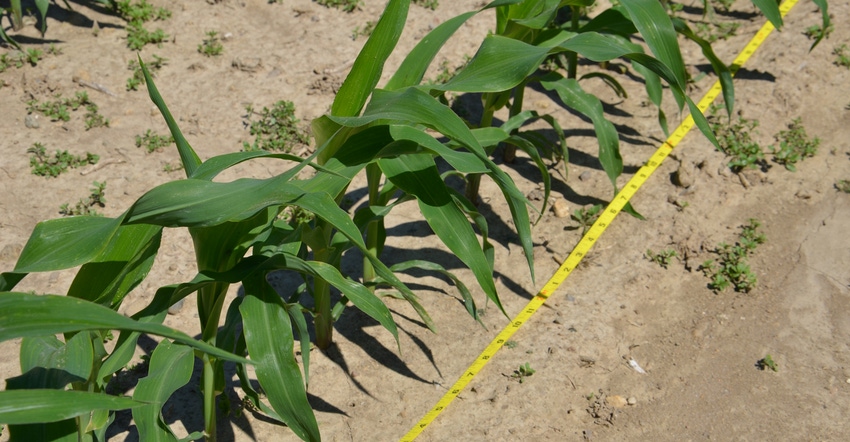
You can learn at least three things from scouting a cornfield with a tape measure. Did the planter space plants correctly? Did insects, disease or other factors affect the stand? Did you achieve the overall plant population you were after?
You can get partial answers on all three questions whenever you scout, but scouting early gives you the most helpful information, notes Dave Nanda, an independent crops consultant, Indianapolis. He prefers to begin scouting when corn is about knee-high. That’s roughly the V5 stage, or five-leaf stage, using the leaf collar method. He takes overall stand counts and evaluates plant spacing.
Here are three questions you can answer by scouting and doing stand counts.
1. Did the planter space plants correctly? Mark off one-thousandth of an acre with a long tape. In 30-inch rows, that’s 17 feet, 5 inches. Measure spacing between plants, first in one row and then in its neighboring row. You will wind up with a series of numbers, such as 6-7-7-5. These represent the distances between plants. Repeat this at several places in the field and compute an average.
Especially early in the season, before other factors might account for missing plants, this gives you a feel for whether your planter spaced plants evenly or not, Nanda says.
For many years, Bob Nielsen, a Purdue University Extension corn specialist, took these counts in many fields across the state. He computed a standard deviation. The more inconsistent the spacing, the higher the standard deviation. Anything above a standard deviation of 2.0 meant the planter may need refurbishing. At high standard deviations, Nielsen concluded from data that you could lose up to several bushels of yield per acre.
2. Did disease, insects or other factors impact stands? If you’re measuring spacing between plants and find a 12-inch gap now and then, it could be something besides planter performance. Perhaps the seed didn’t germinate, Nanda says. Warm germination test scores on most seed is usually around 95%. That means about one seed in 20 won’t germinate, leaving a gap.
The gap may also mean that an insect destroyed the seedling or plant. Or maybe the seed/seedling succumbed to seedling rot or seedling blight. If it’s later in the season, maybe the plant emerged so late it was a weed. Look for patterns in rows and in different rows across the field if you notice these types of gaps, Nanda says.
3. Did you achieve the overall desired plant population? Look back at your notes to see what the seeding rate and intended final population was for the field, Nanda suggests. Then measure the stand. Use the same tape, counting plants in 17 feet, 5 inches of row, for 30-inch rows, on both sides of the row. Repeat the process at least half a dozen times in similar areas of the field to determine an average. If you planted more than one hybrid in the field, repeat your counts in each hybrid.
If there is a larger gap between seeding rate and final population than desired, you can look at several factors. Planter performance, germination percentage, insect and disease pressure and even more factors may be on your list.
About the Author(s)
You May Also Like




